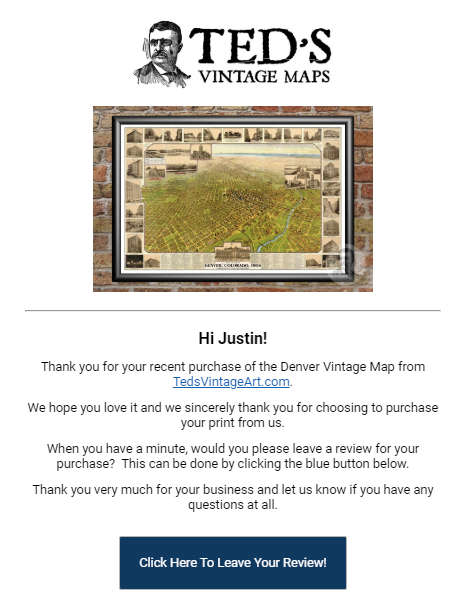Automated email sequences are designed to be sent to users after they take certain actions, such as signing up for an email newsletter or making a purchase. These perfectly crafted emails may seem like they were created just for you, but in reality, they are a part of a brand's email marketing campaign known as "automated sequence emails."
Read on to learn more about automated email sequencing and its benefits and to see some email sequence examples.
What is an email sequence, and what are its benefits?
As the name suggests, an email sequence is a string of emails that are automatically sent to an email list based on the actions subscribers take. Here are some examples of those kinds of actions:
- Signing up for your email list
- Adding an item to a shopping cart but not making a purchase
- Downloading your free e-book
- Making a purchase
Editor's note: Looking for the right email marketing service for your business? Fill out the below questionnaire to have our vendor partners contact you about your needs.
Why is email sequencing important?
Email sequencing can be useful for generating new leads and sales. According to a Content Marketing Institute study, 91% of business-to-business marketers rated email as an important or extremely important marketing channel; however, only 51% of companies are currently using marketing automation.
That means there is a huge opportunity for businesses that aggressively pursue an email marketing strategy that leverages email sequencing.
Benefits of email sequencing
Three major benefits of email sequencing are increased efficiency, better results and a reduction in errors.
Increased efficiency
When you use email sequencing campaigns that launch automatically based on the triggers you set, it reduces the amount of day-to-day labor needed to manage your email marketing. In fact, in a survey by Constant Contact, 30% of professionals reported that saving time was the biggest benefit of marketing automation (including email sequencing).
Better results
If it ever feels like your emails are getting lost in the void, it could signal that your audience is not engaged. To boost your success rate, follow these automated email marketing tips:
- Send the right emails at the right time.
- Segment emails by buyer persona.
- Keep prospects engaged over a long or short sales cycle.
- Stay top of mind.
Reduction in errors
When you track leads and send emails manually, there is room for error. Through email marketing automation, you can create a set of standard emails to go out over the course of each customer's sales journey and set triggers for when the emails should be sent as part of a streamlined, error-reducing workflow.
Email sequencing best practices
When creating your email sequences, follow these best practices:
Space out your email sequences, and target user interests.
Because every business is unique, you may need to experiment with the frequency of your email sequences to see what works best. Consider sending emails at the following rates:
- Five emails when the average time between purchases is less than two weeks
- Two emails when the average time between purchases is one month
- One email when the average time between purchases is three months
- One email when the average time between purchases is six months
- One email when the average time between purchases is 12 months
Test the sequence length.
A common question to ask when getting started with automated email sequencing is, how long should my sequences be? It depends. Length will work hand in hand with frequency and your buyers' journeys. The cycle will end at some point.
You need to figure out how many emails it takes to get your desired result. Some businesses may find that three emails per sequence is enough to get the job done, while others may need to send more than 10. Use email marketing reporting to help you decide what is working. If you are seeing a drop-off in open rates, you may be sending too many emails. If your open and click-through rates are good but conversions are poor, may need to rework your creative content.
Consider these examples submitted by LaToya Russell, founder of The OBM Office and Quitting Corporate.
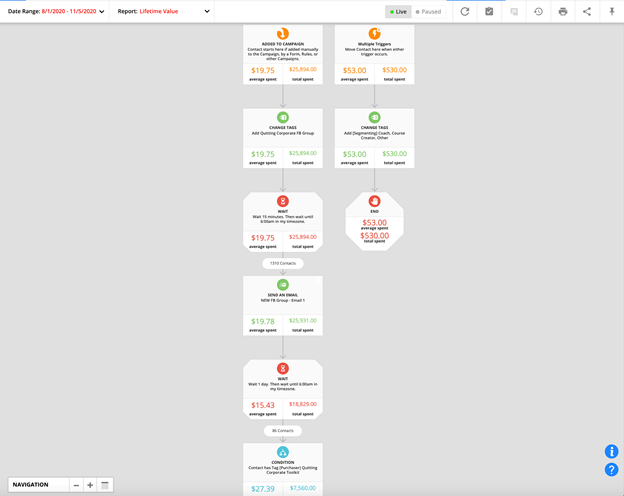
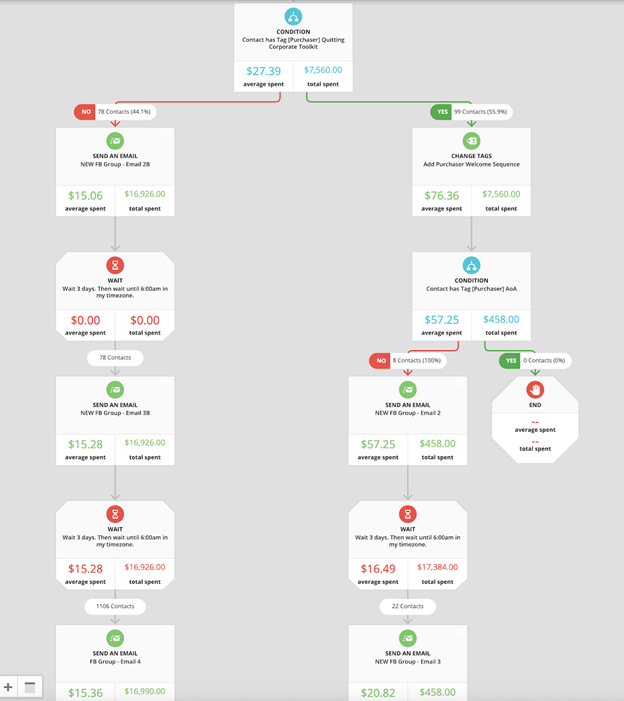
Use language that speaks to your buyer personas.
The language you use in your email campaigns should be catered to your buyer personas, which are fictional representations of your target customers. Consider the following applications of targeted language:
- A law firm may use language that is formal and serious.
- A clothing boutique may use language that is fun and flirty.
- A life coach may use language that is empathetic and informal.
Types of email sequencing with examples
There are five standard types of automated email sequences: onboarding, engagement, cart abandonment, launch and nurture.
Onboarding email sequences
An onboarding email sequence (sometimes called a welcome email sequence) is the first series of emails your subscribers get when they sign up for your email list, app or other offerings that require them to give you their email address.
As part of the onboarding sequence, you get to share what your brand is all about and make a good impression. To help make that good impression, depending on what your promise was to get them to opt in, you may do the following:
- Share a limited-time promo code for new subscribers
- Explain what they can get from being part of your email community
- Get them to connect with your brand on social media
- Engage them with a video that offers helpful tips
Shop Lit Live, a community for consumers to discover brands and products through livestreamed events and multimedia content, shares this first email when consumers register on the brand's app:
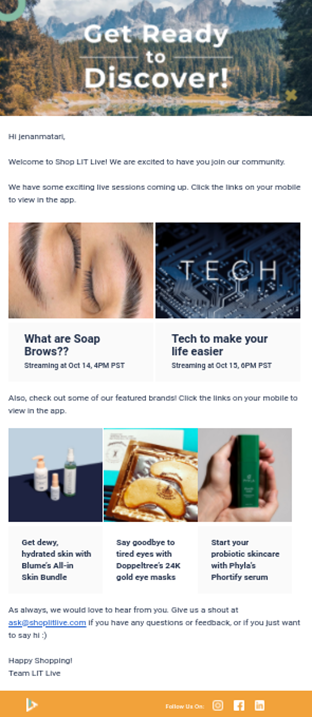
"The welcome email (the first in a series) welcomes customers into our community," said Toby Zhang, CEO of Shop Lit Live. "We personalize communications to each member of our community to help them discover brands, products and content that are most relevant to them."
Engagement
As the name suggests, the purpose of engagement emails is to keep your contacts engaged. Engagement emails can be used to persuade prospects who have not made a purchase to do so. These types of emails can also be used to re-engage people who purchased from your company in the past. In the following example, Russell entices prospects to move further along in the sales process by providing valuable information in the form of a free minicourse:
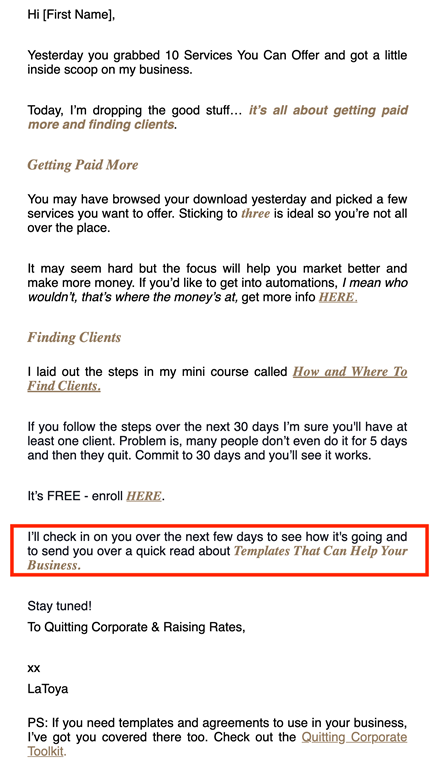
"The goal is to get them to purchase," Russell said. "In the online space, many individuals are often skeptical to purchase from brands that are not widely known, because of scams. Communicating early helps individuals realize that you are a real business; this minimizes support emails and refund requests. You also want to give some encouragement. Let them know it was a wise decision (because sometimes, spending money is hard)."
Ted's Vintage Maps has a sequence designed to engage customers who have not purchased in a while. The company sends an email thanking them for their business and asking them to be part of a process that helps to educate future customers.
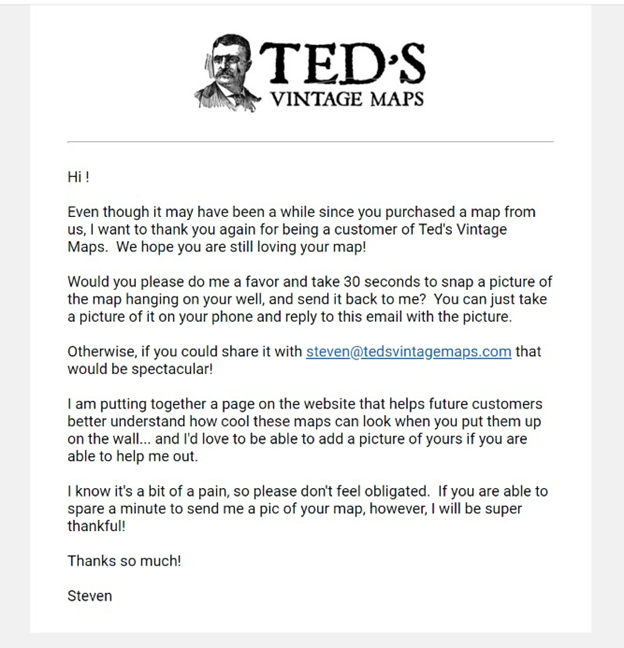
These types of emails serve as reminders about your company and can trigger repeat purchases.
Cart abandonment
Abandoned shopping cart emails, one of the most popular types of emails, are among the easiest to set up, especially on a platform like Shopify.
Organic baby clothing company TØY Baby Clothing sends shopping cart reminders for two reasons, according to Iwona Ordon, the company's founder and chief operating officer.
The first reason is that, because parents are extremely busy, they often cannot finish their purchase at a given moment, and they may end up forgetting about the order, Ordon said. This example serves as a gentle reminder of their abandoned cart:
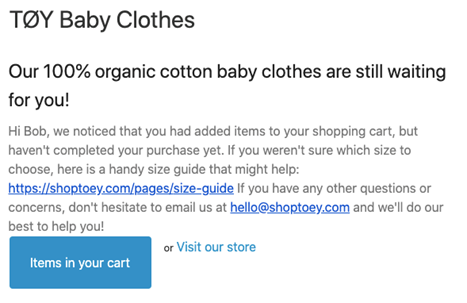
The second reason is that some customers are confused about which size they should choose and, in turn, abandon their cart. The company's sizing goes by height and not age, "which is more of a European standard than a U.S. practice," Ordon said.
Therefore, in her company's shopping cart emails, her team includes a link to a proper size guide that helps prospects find the perfect size for their baby.
Ted's Vintage Maps also uses abandoned shopping cart emails, and the company incorporates an image of the product to help engage prospects, as in this example:
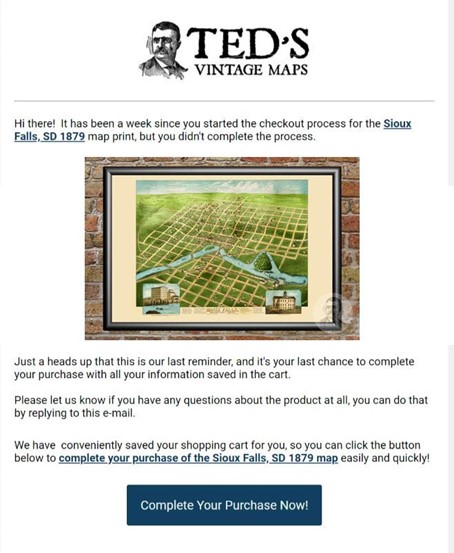
The company's founder, Justin Blase, explained his process and offered a visual of his workflow chart:
- Email a shopper who abandoned their cart.
- Wait 45 minutes after an item is added to their cart.
- Check whether the purchase was completed.
- If it was not completed, send an email that links the shopper back to their "prefilled" cart.
- Wait another seven days.
- Send another email enticing them to complete their purchase.

Launch
Launch emails are sales emails that have a specific theme. It can be exciting for your passionate customers to receive these emails because they love your brand and want to learn all about its new products and services. The goals of launch emails are to create awareness of your new products and services and to earn repeat customers or new customers.
Cuddle Clones introduces prospects and customers to its new products through a series of automated emails, as shown in this example of an email introducing the company's new holiday face masks:
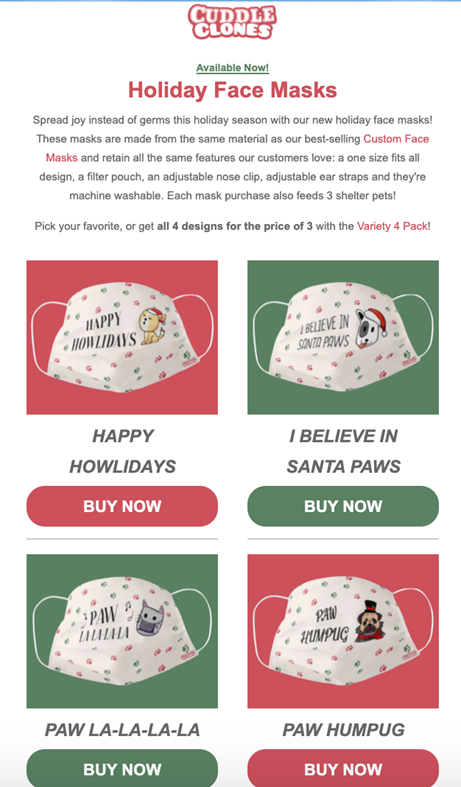
Nurture
Nurture emails, also called follow-up emails, are sent after a customer makes a purchase. The purpose of nurture emails is to get the customer to take a new action, such as review their purchase, upload a photo of their product to your social media pages or make another purchase.
Nurture emails can also be used to help build relationships with your customers and ensure they had a good experience. Blase explained the process Ted's Vintage Maps uses for nurture emails:
- Email 1: Thank a customer for their purchase and ask them to like Ted's on Facebook. This email is sent five minutes after the purchase, in the form of a personalized email.
- Email 2: Ask the customer to leave a review on the company's website. This email is sent within days of the purchase, in the form of a personalized email, as shown in the example below.
- Email 3: Ask the customer to take a picture of their product in their home and share it with the company. This email is sent 15 days after the purchase, in the form of a personalized email, and also serves the dual purpose of encouraging engagement.
